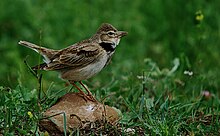
The calandra lark or European calandra-lark breeds in warm temperate countries around the Mediterranean and eastwards through Turkey into northern Iran and southern Russia. It is replaced further east by its relative, the bimaculated lark.

The bimaculated lark breeds in warm temperate countries eastwards from Turkey into Central Asia. It is the eastern counterpart of its relative, the calandra lark.

The black lark is a species of lark in the family Alaudidae found in south-eastern Russia and Kazakhstan.

The Malabar lark, or Malabar crested lark is a species of lark in the family Alaudidae found in western India.

The bird genus Eremophila comprises the two horned larks.

Alaemon is a genus of birds in the family Alaudidae, commonly called hoopoe larks.

The paradise flycatchers (Terpsiphone) are a genus of birds in the family Monarchidae. The genus ranges across Africa and Asia, as well as a number of islands. A few species are migratory, but the majority are resident. The most telling characteristic of the genus is the long tail streamers of the males of many species. In addition to the long tails the males and females are sexually dimorphic and have rufous, black and white plumage.
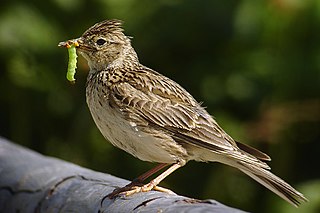
Alauda is a genus of larks found across much of Europe, Asia and in the mountains of north Africa, and one of the species endemic to the islet of Raso in the Cape Verde Islands. Further, at least two additional species are known from the fossil record. The current genus name is from Latin alauda, "lark". Pliny the Elder thought the word was originally of Celtic origin.

The singing bush lark or Horsfield's bush lark is a species of lark which inhabits grassland throughout most of Australia and much of Southeast Asia. It was described by the American naturalist Thomas Horsfield.

Galerida is a genus of birds in the family Alaudidae. The current scientific name is derived from Latin. Galerida was the name for a lark with a crest, from galerum, "cap". The name Galerida is synonymous with the earlier genus names Calendula, Heliocorys and Ptilocorys.
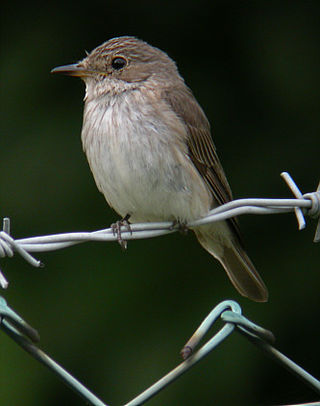
Muscicapa is a genus of passerine birds belonging to the Old World flycatcher family Muscicapidae, and therein to the typical flycatchers of subfamily Muscicapinae. They are widespread across Europe, Africa and Asia with most species occurring in forest and woodland habitats. Several species are migratory, moving south from Europe and northern Asia for the winter.
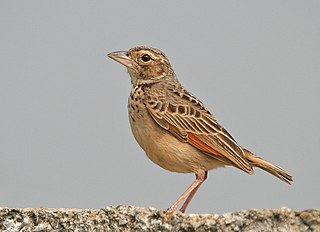
Mirafra is a genus of lark in the family Alaudidae. Some Mirafra species are called "larks", while others are called "bush larks". They are found from Africa through South Asia to Australia.

The thick-billed lark or Clotbey lark is a species of lark in the family Alaudidae.

Spizocorys is a genus of African larks in the family Alaudidae found in southern and eastern Africa.

The bar-tailed lark or bar-tailed desert lark is a species of lark in the family Alaudidae. Two other species, the rufous-tailed lark and the Cape clapper lark are both also sometimes referred to using the name bar-tailed lark. It is found from Morocco to Pakistan. Its natural habitat is hot deserts. This is in many places a common species, but elsewhere rather less common. It has a very wide distribution and faces no obvious threats, but surveys have shown that it is slowly decreasing in numbers. The International Union for Conservation of Nature has rated its conservation status as being of "least concern".

Hume's short-toed lark is a species of lark in the family Alaudidae. It is found in south-central Asia from Iran and Kazakhstan to China.
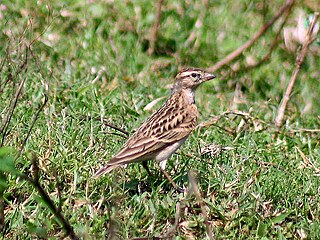
Calandrella is a genus of larks in the family Alaudidae.

Heteromirafra is a small genus of African larks in the family Alaudidae.

The Tibetan lark is a species of lark in the family Alaudidae found on the Tibetan plateau from north-western India to central China. Alternate names for this species include the Asiatic lark, long-billed calandra lark and long-billed lark.

The Mongolian lark is a species of lark in the family Alaudidae found from southern Russia and Mongolia to central China. The Mongolian Lark is known for its elaborate singing and even well into adulthood, is able to learn new songs. While female Mongolian Larks don’t sing, they have noteworthy song control nuclei with strong connectivity. Male Mongolian Larks have large song bouts and song phrases that allow them to have extremely large song control nuclei.
